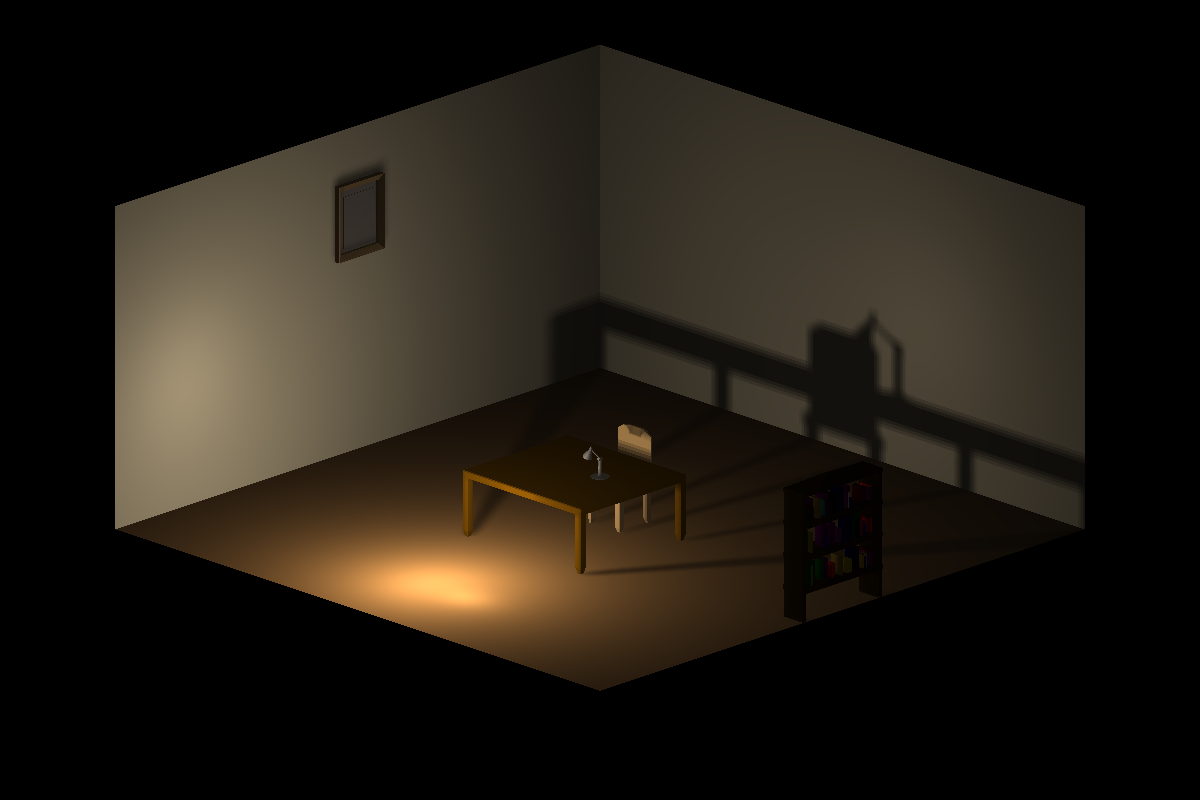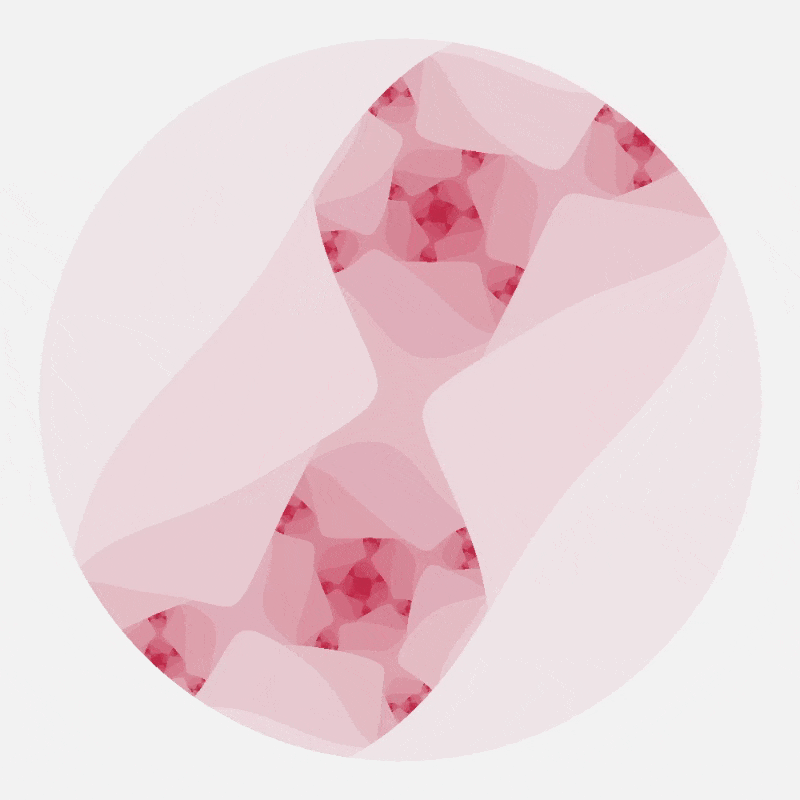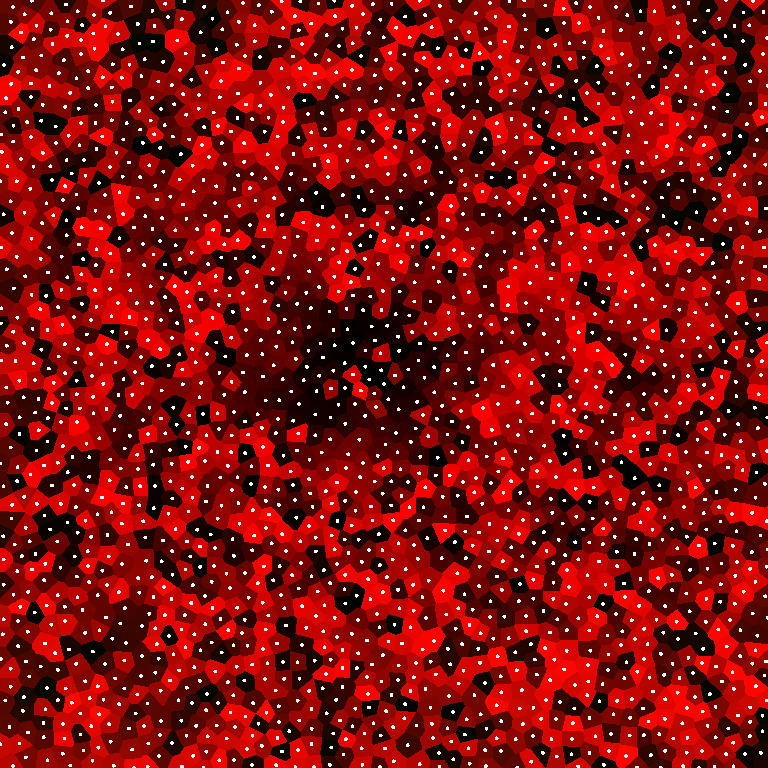Small OpenGL based 2D/3D Engine / Wrapper in C++
Supported on GNU/Linux and MacOS
 Simple generated perlin-noise heightmap rendered with normal vectors as colors (Example Program 2)
Simple generated perlin-noise heightmap rendered with normal vectors as colors (Example Program 2)
LINES OF CODE (without unreasonable compression):
Main File: 198
Main Classes: 313
Utility Classes: 743
Helpers Namespaces: 733
Core Total: 1254
Total: 1987
History:
12. Apr 2020: 885
29. Apr 2020: 1116
17. May 2020: 1667
23. May 2020: 1065
01. Aug 2020: 1145
21. Feb 2021: 1378
27. Jul 2021: 1943
26. Jan 2022: 1969
26. Nov 2022: 1928
20. Mar 2023: 1987
Note: If you are using TinyEngine for any projects, please let me know!
Based on many previous OpenGL projects, I have a good idea of what features I need in an engine to build visually appealing visualizations of generated data. Many of the projects had the same overarching structure, and used the same OpenGL wrapping structures. This engine unifies those basic concepts.
The goal of this "engine" is to act as an intuitive wrapper for boilerplate OpenGL, allowing for quick and easy development of 2D / 3D visualizations of generated data. I also want to keep it as small as possible, giving only necessary abstractions of boilerplate OpenGL code, and doing the rest with user-defined behaviors passed to the engine.
This is also a learning project, for practicing engine / systems design. This is not intended as an optimized game development library, but can be used to generate beatiful visualizations of generated data.
If anybody likes the structure, they are free to adopt it or recommended additions / changes.
As I continue to build projects using this engine, I plan on slowly expanding its feature set, as long as new features fit elegantly into the overall structure and offer a large amount of functionality for little additional effort.
Animated Julia-Set (Example 4). See my blog here.
The main engine interface is wrapped in a namespace Tiny. This namespace has three (global) static members, which are its main component classes:
- View Class (Tiny::view): Window handling, rendering, GUI interface
- Event Class (Tiny::event): Event handling for keyboard and mouse, window resizing
- Audio Class (Tiny::audio): Audio interface for playing / looping sounds
A number of utility classes wrap typical OpenGL features into easily useable structures. These have simple constructors and destructors that wrap the necessary OpenGL so you don't have to worry about it:
- Texture: OpenGL texture wrapper with constructors for different data types (e.g. algorithm, raw image, ...)
- Shader: Load, compile, link and use shader programs (vertex, fragment, geometry) easily, pass SSBO.
- Compute: Derived from Shader, allows for compute shader dispatching
- Buffer: OpenGL Buffer Object wrapper. Allows for easy templated loading and data retrieval for the GPU.
- Model: OpengL VAO/VBO wrapper. Construct from user-defined algorithm. Handles loading, updating, rendering.
- Target: OpenGL FBO wrapper. Bind one or multiple textures for render targeting. Handles 2D (billboards) and 3D (cubemaps).
- Instance: OpenGL instanced rendering wrapper (any Model object, any data). Simply add model buffers and render model instanced.
More information can be found on the wiki: Utility Classes
The behavior is combined through a standard game pipeline. The programs behavior is additionally changed through user-defined functions which are called in the relevant parts of the pipeline:
- Tiny::event.handler: Lets you define behavior based on user-inputs. Tiny::event stores input data
- Tiny::view.interface: Lets you define an ImGUI interface that can act on your data structures
- Tiny::view.pipeline: Combines utility classes to render your data structures to targets / windows
- Tiny::loop: Executed every cycle. Arbitrary code acting on your data structures every loop
A number of helper namespaces then supply additional algorithms and functions that are useful.
All of the programs shown below are highly interactive and allow for live manipulation of the scene. All of them run in real time and allow for camera movement. Read the very brief example programs to see how TinyEngine is used to construct nice visualizations using very little code.
 A procedural 3D tree (example program 6), that has a leaf particle system and orthogonal projection shadow mapping.
A procedural 3D tree (example program 6), that has a leaf particle system and orthogonal projection shadow mapping.
 A simple scene (example program 9) that uses .obj / .mtl files generated in Blender, and then uses cubemaps for point-light shading.
A simple scene (example program 9) that uses .obj / .mtl files generated in Blender, and then uses cubemaps for point-light shading.
An example image of a shader-based voronoi texture generator I implemented as a small experiment (example program 11). Lets you do real-time voronoi filters because its very fast. Here seen for N = 2048. See my blog here here.
A rendering of a dynamic alpha-blended voxel scene which uses a technique called vertex pooling to reduce driver overhead while drawing. See my blog here
A simple implementation of a 2D Lattice Boltzmann Method, showcasing vortex shedding. See my blog here
A 3D cloth simulation, implemented using compute shaders performing a time-integration over a set of particles connected using springs.
As the code-base is extremely brief, I recommend reading through the code and the example programs to understand how it works. The Wiki contains more information on the individual functions of the classes and how they are used.
Building a program with TinyEngine is extremely simple!
Example Program 0:
#include <TinyEngine/TinyEngine>
int main( int argc, char* args[] ) {
Tiny::window("Example Window", 600, 400); //Open Window
Tiny::event.handler = [&](){ /*...*/ }; //Define Event Handler
Tiny::view.interface = [&](){ /*...*/ }; //Define ImGUI Interface
/*...Define Utility Classes...*/
Tiny::view.pipeline = [&](){ /*...*/ }; //Define Rendering Pipeline
Tiny::loop([&](){ //Start Main Game Loop
//... additional code here
});
Tiny::quit(); //Close the window, cleanup
return 0;
}Check the TinyEngine Wiki for more information on how to construct a basic program. Read the example programs to see how the utility classes are combined to create interactive 2D and 3D programs using OpenGL in very little code.
As of 2021, TinyEngine is built as a statically linked library for easier inclusion in your project. This has a number of benefits:
- TinyEngine does not need to be copied into your project directory
- Easier continuous maintenance and updating
- Faster compilation times
The installation process occurs in the makefile (valid for all operating systems):
make setup #Copy Core Header Files to Install Location
make helpers #Copy Helper Headers
make install #Compile TinyEngine and Copy to Install Location
make all #All of the above! Run this for easy install.
make examplesThe default install locations are $(HOME)/.local/lib for the compiled library and $(HOME)/.local/include for the header files.
Check the (brief!) makefile for options (e.g. install location, compiler flags).
Note that the installation has only been tested on GNU/Linux and install locations might need tuning for your system.
Building a project by default only requires inclusion of the TinyEngine header
#include <TinyEngine/TinyEngine>and optionally any helper namespace headers, e.g.
//...
#include <TinyEngine/object>
#include <TinyEngine/image>
//...TinyEngine standalone is linked using:
-lTinyEnginebut also requires linking of all additional dependencies! See the example programs to see exactly how to link the program (makefile). Note that all makesfiles are identical! Different operating systems have slightly different linkage.
Compiled using g++ on Ubuntu 18/20 LTS, Fedora 33 and MacOS Big Sur.
In case your computer / graphics card does not support the latest versions of OpenGL, you can compile your program by defining the additional macro TINYENGINE_COMPATIBILITY, i.e.:
gcc main.cpp -D TINYENGINE_COMPATIBILITY -o mainThis will reduce the version to a compatibility version, reducing some features (i.e. lower GLSL versions), but allowing for 95% of all features to operate normally.
Note that some examples rely on features introduced in OpenGL4+, meaning that the required version of GLSL will not be available. All example programs are reduced to the minimum necessary version.
TinyEngine supports the embedded shipping of resources in executables in a native way. It does this by utilizing c-embed and desiging file-loading structures to use an <stdio.h> style interface. To ship your resources (i.e. shaders, images, .obj files) as embedded in the executable, use the c-embed style make rule as follows:
DAT = resource #resource directory to embed (e.g. /shader/)
.PHONY: embedded
embedded: CEF = $(shell c-embed $(DAT)) c-embed.o -include /usr/local/include/c-embed.h -DCEMBED_TRANSLATE
embedded:
$(CC) main.cpp $(CF) $(LF) -lTinyEngine $(TINYOS) $(TINYLINK) -o main ${CEF}For a working example, read the c-embed documentation and see the TinyEngine examples. All examples have been provided with an embedded rule. Running make all results in relative path dependency, while running make embedded embeds the resource folder as a virtual filesystem while the code remains entirely unchanged.
Currently Implemented Loading Interfaces:
- Shaders
Not-Yet Implemented Loading Interfaces:
- Images
- Object Files
Currently TinyEngine has only been tested on linux (Ubuntu 18 LTS, Fedora 33) and MacOS. It would be possible to port to windows, but I lack a dedicated windows development environment to reliably port it. I might do this in the future.
- OpenGL3: apt-get install libglu1-mesa-dev
- SDL2: apt-get install libsdl2-dev libsdl2-ttf-dev libsdl2-mixer-dev libsdl2-image-dev
- GLEW: apt-get install libglew-dev
- Boost: apt-get install libboost-system-dev libboost-filesystem-dev
- GLM: apt-get install libglm-dev
- DearImGUI (already included!)
- g++ (compiler)
Optional:
- c-embed: https://github.com/weigert/c-embed
In a single command:
sudo apt-get install libglu1-mesa-dev libsdl2-dev libsdl2-ttf-dev libsdl2-mixer-dev libsdl2-image-dev libglew-dev libboost-system-dev libboost-filesystem-dev libglm-devFor systems with dnf as package manager, the dependencies can be installed using:
sudo dnf install make gcc-c++ glew-devel SDL2-devel SDL2_image-devel SDL2_ttf-devel SDL2_mixer-devel boost-devel glm-develTo install on MacOS, you need to install xcode commandline tools:
sudo xcode-select --installThen, to install the dependencies, I recommend installing homebrew from here and installing the packages:
brew update
brew upgrade
brew install gcc
brew install glew
brew install sdl2
brew install sdl2_image
brew install sdl2_mixer
brew install sld2_ttf
brew install glm
brew install boostNote that MacOS only supports a specific OpenGL version, giving access to GLSL versions 330 to 410 (including core profiles). This affects which examples can be run, depending on what GLSL versions they need. Be aware of this when writing your own programs. (Credit: User CodingWatching)
Note that you might get the following errors if you have binutils installed via homebrew:
ld: warning: ignoring file /usr/local/lib/libTinyEngine.a, building for macOS-arm64 but attempting to link with file built for unknown-unsupported file format ( 0x21 0x3C 0x61 0x72 0x63 0x68 0x3E 0x0A 0x2F 0x20 0x20 0x20 0x20 0x20 0x20 0x20 )
ld: symbol(s) not found for architecture arm64
ld: warning: ignoring file /usr/local/lib/libTinyEngine.a, building for macOS-arm64 but attempting to link with file built for macOS-arm64
See the following issue for more information.
Uninstall homebrew binutils to compile correctly.
brew uninstall binutilsI am currently working on an elegant windows port. Stay tuned.
MIT License




